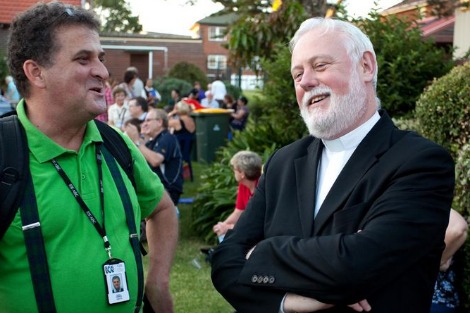The Vatican's Francis Revolution Gains Pace
By Paul Collins
An important power shift has just occurred in Rome, and it has a genuine Australian connection. The long-rupmoured removal of US Cardinal Raymond Burke as Prefect of the Supreme Tribunal of the Apostolic Signatura, the top tribunal in the Vatican’s judicial system, and effectively the appeals court for all other tribunals in the church, occurred at midday on Saturday. Burke has been made Patron of the Sovereign Military Order of the Knights of Malta. His replacement at the Signatura is Archbishop Dominique Mamberti, Secretary for Relations with States, effectively the Vatican’s foreign minister. Mamberti’s replacement is Liverpool-born Archbishop Paul Gallagher, currently papal nuncio to Australia. The sidelining of the 66 year old Burke signifies an important power shift. A bluntly outspoken conservative critic of Pope Francis’ pastoral approach to difficult moral issues, his rejection of a hierarchy of truths (the notion that some teachings are more important than others) has placed him at the far right of the Catholic spectrum. Burke has said that Catholicism risks schism if bishops at the Family Synod next year ‘go contrary’ to the Church’s established dogmas. A ‘folk hero’ for some Catholics, Burke was appointed bishop of La Crosse, Wisconsin, in 1994, and promoted to Archbishop of St Louis in late 2004. He was appointed Prefect of the Signatura in 2008 and was made a cardinal in November 2010. He exercised considerable influence on the appointment of new bishops in the US as a member of the Congregation of Bishops. He was removed from the Congregation by Pope Francis in December 2013. His dismissal from the Signatura was certainly brutal by Vatican standards. The Roman saying is ‘Let him be promoted that he may be removed’, but with Burke they didn’t even pretend he was being ‘promoted’. Perhaps it is because he had ‘leaked’ his own demotion some weeks earlier. He is known for his devotion to the Tridentine liturgy and practices such as wearing a cappa magna. He has claimed that contemporary ‘moral corruption’ is ‘strictly correlated’ to the liturgical ‘abuses’ that in his view came in the wake of Vatican Council II. Whispers in the Loggia blogger Rocco Palmo has described him as ‘arguably the most polarising figure on the global Catholic stage.’ His removal from the Signatura and Bishops strips him of any real influence on the wider church - at least for this papacy. Burke’s replacement at the Signatura is Archbishop Dominique Mamberti, a Corsican. This leaves his very senior and important post of Secretary for Relations with States vacant. The Secretariat of State is the central body of the curia and is presided over by the Secretary of State, currently Cardinal Pietro Parolin. He is effectively the papal prime minister. Serving directly under him are two under-secretaries with the rank of archbishop, one for Ordinary Affairs (this person runs the curia and deals with general matters concerning the church) and the other for Relations with States i.e. the Vatican’s dealings with foreign governments. Thus the secretary of this section becomes the Vatican’s foreign minister. 60 year old Paul Gallagher’s appointment as Secretary for Relations with States comes as a surprise to many, although he is a close friend of Parolin. He returns to Rome as a cleanskin ‘who is not part of any clique’, and as someone of real competence. Rocco Palmo says he is ‘the first native born English speaker to hold the post.’ This is not strictly true. Australian-born Archbishop (later Cardinal) Edward Cassidy was Secretary for Ordinary Affairs from 1988-9. Gallagher was born in Liverpool, near where the Beatles came from. Ordained in 1977, he did parish work in Liverpool, graduated from the Gregorian University in Canon Law and entered the Vatican diplomatic service in 1984. He served in Tanzania, Uruguay, the Philippines and at the Council of Europe. He was ordained archbishop to the titular see of Hodelm (an extinct Scottish diocese) and was appointed Nuncio to Burundi in early-2004 in succession to the murdered Irish Nuncio, Archbishop Michael Courtney who had worked for peace during the vicious civil war in Burundi. Gallagher later served as Nuncio in Guatemala and was appointed to Canberra in April 2013. He also worked for several years in the Secretariat of State, so gaining experience in the affairs of the curia. He has been popular in Australia because he has kept in touch with pastoral life. For example he volunteered to help out in the far-flung western NSW of Diocese of Wilcannia-Forbes during his first Easter in Australia. He’s also been willing to talk to Catholics from across the ecclesiastical spectrum. This puts him very much in line with Francis’ emphasis on the need for church administrators to keep in touch with real world ministry. While Gallagher’s appointment to Rome will be a real loss for the Australian church, it does mean that there will be someone in an influential position who knows Australia well. He might even be able to influence the appointment of new Australian bishops. That would be a good thing!
|
.
Any original material on these pages is copyright © BishopAccountability.org 2004. Reproduce freely with attribution.
